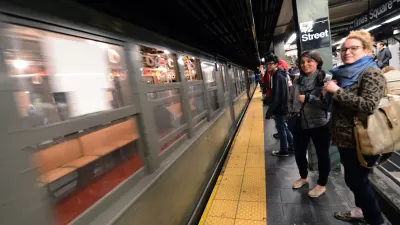Despite significant investment in transit infrastructure, and renewed interest in downtowns and walkable neighborhoods, new data shows that gains in transit commute mode share have been hard to come by in America’s largest cities, says Kaid Benfield.
"As most readers know only too well, the US pales by comparison to the rest of the world when it comes to getting around by anything other than single-occupancy cars," writes Benfield in a recent blog post. He adds, "[s]lowly but surely, the trend is now beginning to reverse as the hot markets are in downtowns and walkable neighborhoods, with the ones having good transit service commanding the highest premiums on a per-square-foot basis."
Despite these new trends, Benfield finds mixed results in the findings of a recent analysis examining 2011 American Community Survey results regarding metropolitan commuting patterns. Only New York City and Washington D.C, who lead in general transit usage with commute mode shares of 31.1 percent and 14.8 percent, respectively, significantly increased their transit mode shares in the last decade. New York, Boston and San Francisco all led the way in walking to work, with shares of 6.3 percent, 5.3 percent and 4.3 percent, respectively.
Nationwide, bike commuting is still relatively low, with most cities registering fewer than 2 percent shares. Portland (topping the list) and three Californian cities (the Bay Area, San Jose/Silicon Valley, and Sacramento) were the exceptions. Of interest, notes Benfield, is the finding that the 10 longest commutes all average around 30 minutes, a statistic that "has been fairly stable for centuries; only the modes and distances have changed."
FULL STORY: Which US metros have the greenest commuting habits?

Pennsylvania Mall Conversion Bill Passes House
If passed, the bill would promote the adaptive reuse of defunct commercial buildings.

Planning for Accessibility: Proximity is More Important than Mobility
Accessibility-based planning minimizes the distance that people must travel to reach desired services and activities. Measured this way, increased density can provide more total benefits than increased speeds.

World's Largest Wildlife Overpass In the Works in Los Angeles County
Caltrans will soon close half of the 101 Freeway in order to continue construction of the Wallis Annenberg Wildlife Crossing near Agoura Hills in Los Angeles County.

Amtrak Takes Lead on Texas Central Rail
The high-speed rail project isn’t a done deal, but if it moves forward, trains could begin operating in 2030.

Maine Approves Rent Relief Program
Legislators hope the assistance program will help struggling low-income households avoid eviction.

How Transit Architecture Impacts Real and Perceived Safety
More than a third of Americans believe major transit systems are too unsafe to ride. The built environment can change that.
City of Costa Mesa
Licking County
Barrett Planning Group LLC
HUD's Office of Policy Development and Research
Mpact Transit + Community
HUD's Office of Policy Development and Research
Tufts University, Department of Urban and Environmental Policy & Planning
City of Universal City TX
ULI Northwest Arkansas
Urban Design for Planners 1: Software Tools
This six-course series explores essential urban design concepts using open source software and equips planners with the tools they need to participate fully in the urban design process.
Planning for Universal Design
Learn the tools for implementing Universal Design in planning regulations.

























